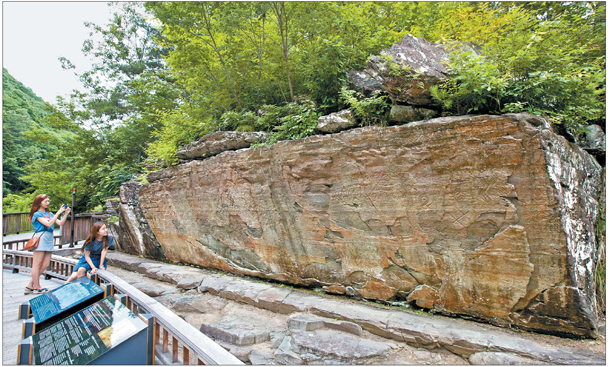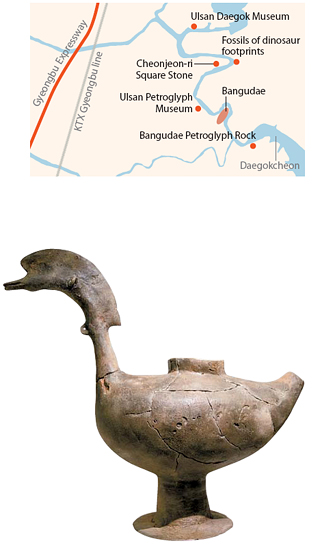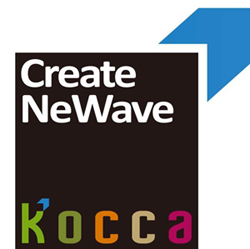Travel back to ancient Korea in Ulju County

Cheonjeon-ri Square Stone on the Daegokcheon stream in Ulju County. Various patterns and writings were engraved on the stone during the Silla Dynasty. [LIM HYUN-DONG]
The area, which includes the city of Ulsan, contains many cultural heritage sites that give a glimpse of how prehistoric peoples lived on the peninsula. They include Bangudae Petroglyph Rock, which has been put on Unesco’s Tentative List for designation as a World Heritage site, and fossils of dinosaur footprints that date back to roughly 100 million years ago.
Ulju County also features state-of-the-art facilities that target young people, including a “smart experience program” through which visitors can learn about local history via cute characters on a tablet screen.
JoongAng Ilbo, an affiliate of Korea JoongAng Daily, recently visited the area to experience its local attractions.

An earthenware duck on display at the Ulsan Daegok Museum.
Though it was only named recently, the Taehwa River 100-ri Road has an ancient past.
The nearly 40-kilometer-long (24.9-mile-long) road was created not by man, but rather was shaped by a prehistoric river.
It begins from Mt. Baekun and extends to the East Sea, leading past numerous bits of cultural heritage.
One of the most interesting sections follows Daegokcheon, one of the Taewha River’s tributaries that still contains water.
Both the Bangudae Petroglyph Rock (National Treasure No. 285) and Cheonjeon-ri Square Stone (National Treasure No. 147), can be spotted by passersby.
These particular sites date back thousands of years. Some 300 engravings on the Bangudae Petroglyph Rock are estimated to date back to the Neolithic Age, between 3,500 to 7,000 years ago. They include diverse images, ranging from whales to humans.
Cheonjeon-ri Square Stone, on the other hand, dates back to the Bronze Age. The stone resembles a movie screen with its 3-meter height and 10-meter width, and it features various patterns and writing. Examples include abstract patterns, presumably from the Bronze Age, and writings from the 6th century A.D. during the age of King Beopheung, or the first king to adopt Buddhism during the Silla Dynasty (57 B.C. to A.D. 935).
“This is a highly meaningful and beautiful rock that even the royal family from Silla Dynasty visited,” said a tour guide standing by the stone when this reporter visited.
Across from the stone, a broad, flat rock marked with many dinosaur footprints can be found. Each footprint is big enough to fit an entire person inside, indicating the creatures’ massive size.
Further down the road, after passing through a bamboo grove, small forests and swamps, Bangudae Petroglyph Rock appears in sight. The rocky mound is said to resemble a turtle lying flat on the ground.
The mound is also known as Poeundae, named after Jeong Mong-ju, a Confucian scholar and high-ranking government official of the late Goryeo Dynasty (918 to 1392). Jeong was often known by his pen name Po Eun, and he stayed at the site during a period of banishment.
When this reporter visited, a tour guide was waiting to explain the ancient site’s history.
“Above the river, there are drawings on the mound. Due to the construction of a dam at the lower part of the Daegokcheon, the drawings are sometimes veiled in the water. However, it is currently viewable as the water level has shrunk in recent days. The best time to enjoy the drawings is between 3 p.m. to 4 p.m. because sunlight shines through the cliff during that hour.”
For those who wish to see the drawings more closely, there is an observatory 70 meters (230 feet) away. This reporter could see many different types of patterns and animals through an installed telescope at 3 p.m. The drawings of whales and boars looked especially clear.
Augmented history
Ulsan Daegok Museum is located about 4 kilometers from the Bangudae Petroglyph Rock. The museum is filled with earthenware and ceramics discovered while constructing the Daegok Dam from 1999 to 2004, and the back of the building offers a nice view of the dam itself.
Ulsan Petroglyph Museum is also nearby the mound. It features full-size recreations of Bangudae Petroglyph Rock and Cheonjeon-ri Square Stone, which are useful for those who want a closer look or couldn’t visit the actual sites because of bad weather.
The museum also offers a smart-experience program. Created by the Ministry of Culture, Sports and Tourism and the Korea Creative Content Agency, the augmented reality (AR) tour is designed to make cultural sites more interesting and easier to understand.
Visitors are given a tablet PC they can use to scan QR codes placed around the museum. When scanned, the QR codes cause an animated character to appear on the tablet to explain something about the prehistoric age.
For example, when visitors scan the code on the Bangudae Petroglyph Rock recreation, characters resembling primitive men pop up and pretend to draw on the rocks.
“Since children can enjoy Korea’s cultural assets with fun contents like a game, they really like the experience,” said Oh Min-jin, a guide for the AR tour.

From left to right: Bangudae Petroglyph Rock, where the late Confucian scholar Jeong Mong-ju from the Goryeo Dynasty stayed during his banishment; engravings on Bangudae Petroglyph Rock can be enjoyed from the observatory; visitors can experience AR tour program at the Ulsan Petroglyph Museum; fossils of dinosaurs can be spotted at the side of the Daegokcheon stream.
It’s about a 4-kilometer walk from Ulsan Daegok Museum to the Cheonjeon-ri Square Stone, Ulsan Petroglyph Museum and Bangudae Petroglyph Rock.
The path is easily walkable in normal sneakers, but since there are no convenience stores along the way, bringing some water or snacks is advisable.
There are tour guides that can offer assistance at the Cheonjeon-ri Square Stone and the Bangudae Petroglyph Rock.
For more details about the Ulsan Daegok Museum, call 052-229-6638 and for the Ulsan Petroglyph Museum, call 052-229-6678. Entrance to both museums is free.
To know more about the AR tour program, dial 052-259-2732. For the AR tour, visitors need to make a reservation in advance. It typically costs 3,000 won ($1.7), but will be available for free until July 31.
BY BAEK JONG-HYUN [jin.minji@joongang.co.kr]











with the Korea JoongAng Daily
To write comments, please log in to one of the accounts.
Standards Board Policy (0/250자)